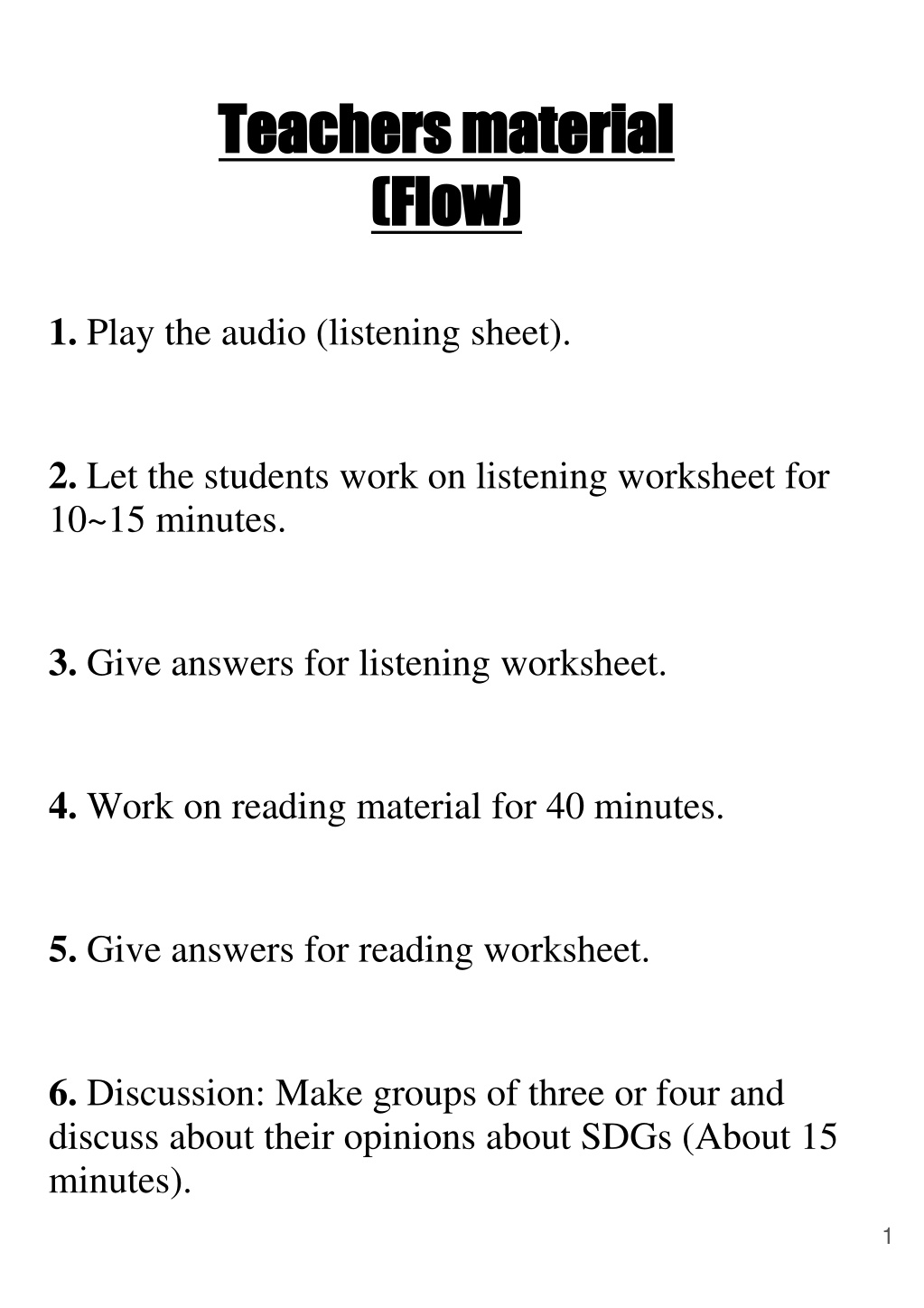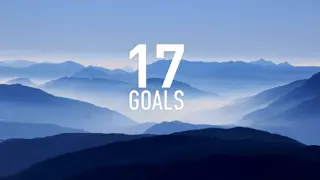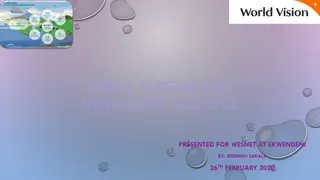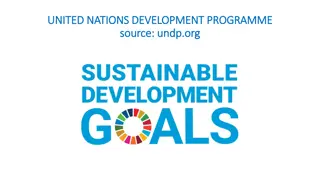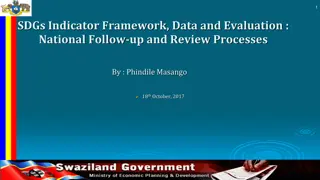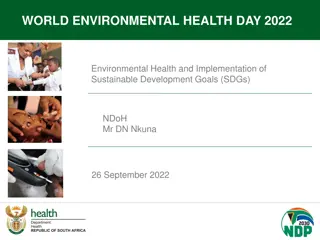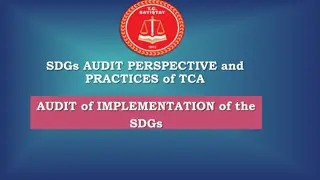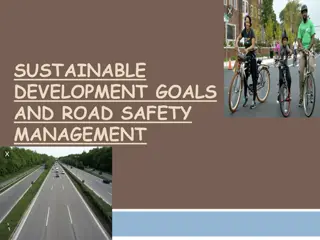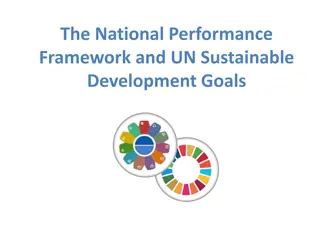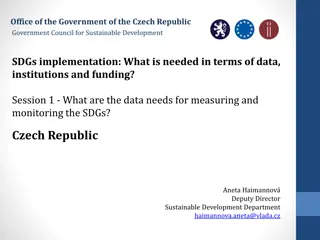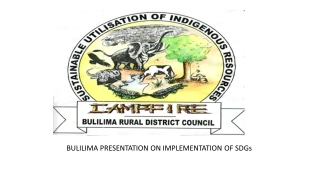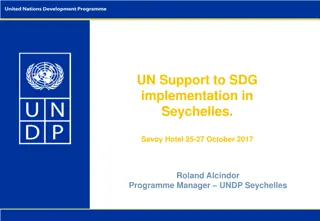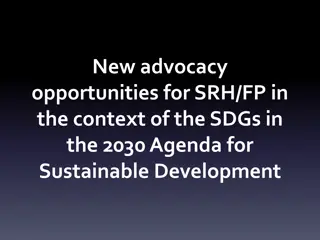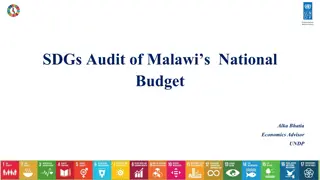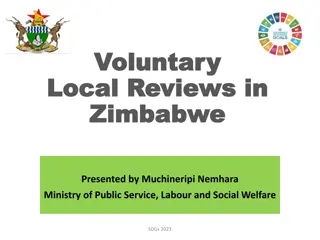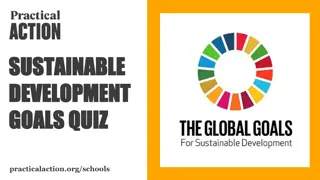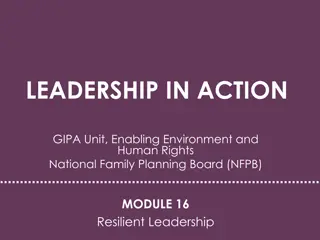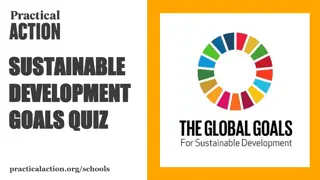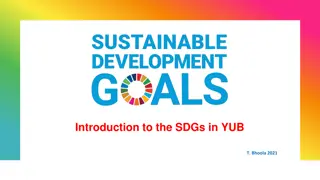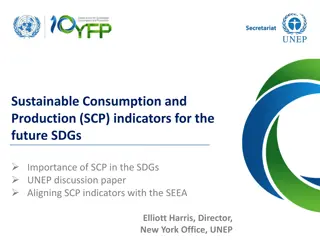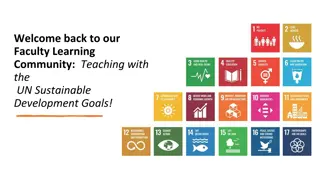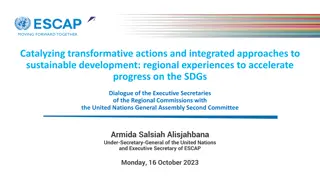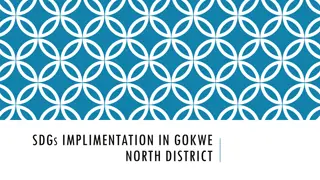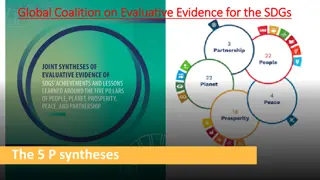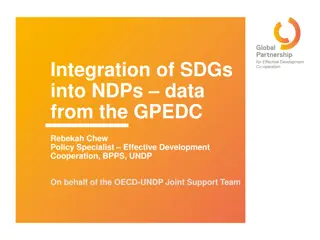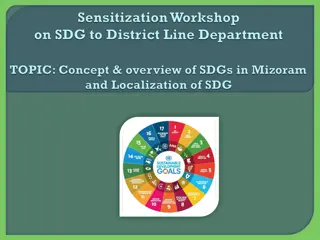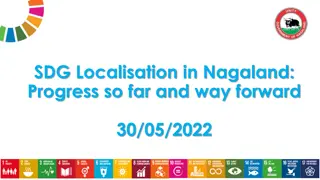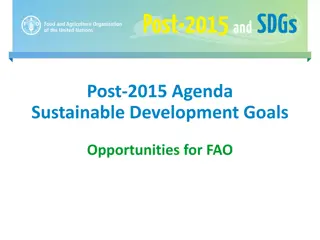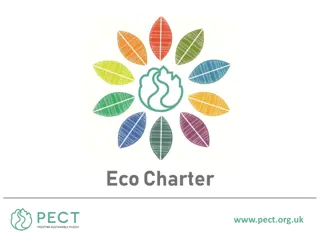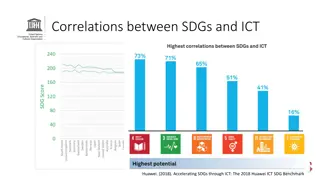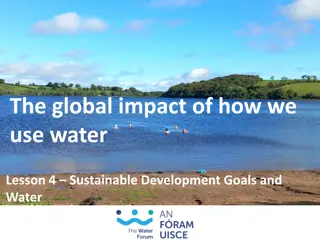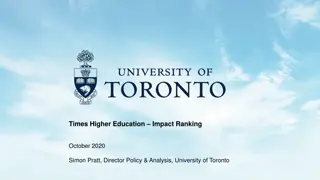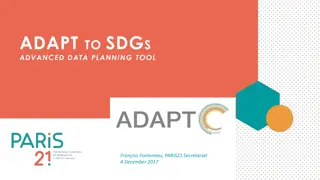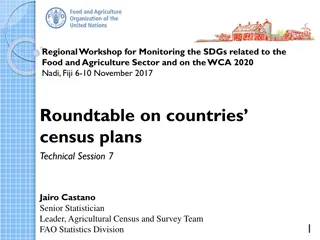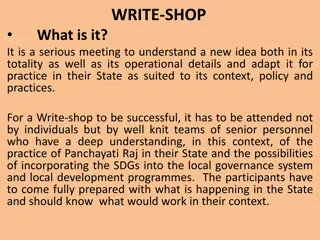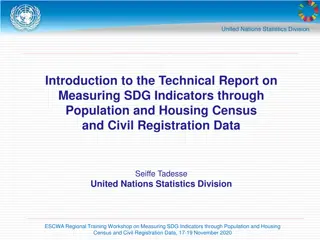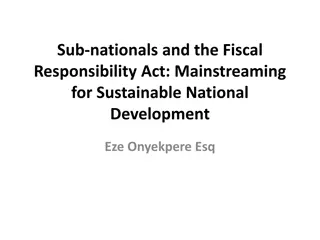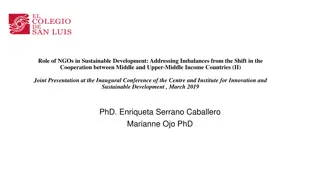Engaging Classroom Activity on Sustainable Development Goals (SDGs)
Dive into an interactive session where students listen to audio, work on a listening worksheet, discuss their opinions on SDGs, and explore reading materials on the history and importance of the 17 global SDGs. The session covers topics such as poverty, hunger, health, education, gender equality, clean water, and more, aiming to educate and inspire a sustainable future through collaboration and action.
Download Presentation

Please find below an Image/Link to download the presentation.
The content on the website is provided AS IS for your information and personal use only. It may not be sold, licensed, or shared on other websites without obtaining consent from the author. Download presentation by click this link. If you encounter any issues during the download, it is possible that the publisher has removed the file from their server.
E N D
Presentation Transcript
Teachers material Teachers material (Flow) (Flow) 1. Play the audio (listening sheet). 2. Let the students work on listening worksheet for 10~15 minutes. 3. Give answers for listening worksheet. 4. Work on reading material for 40 minutes. 5. Give answers for reading worksheet. 6. Discussion: Make groups of three or four and discuss about their opinions about SDGs (About 15 minutes). 1
Listening materials Listening materials Watch two videos and choose the SDGs Goal that match the symbols below Do you know all 17 SDGs? https://youtu.be/qfOgdj4Okdw (~3:40) 20 min The goals Good Health and Well Being Clean Water and Sanitation Partnerships For The Goals Decent Work and Economic Growth Affordable and Clean Energy Peace, Justice and Strong Institution Sustainable Cites and Communities Reduce Inequalities Responsible Consumption and Production Industry, Innovation and Infrastructure Life Below Water Quality Education Climate Action Life on Land Zero Hunger 2 No Poverty
Answers for listening Answers for listening 1. No Poverty 2. Zero Hunger 3. Good Health and Well Being 4. Quality Education 5. Gender Equality 6. Clean Water and Sanitation 7. Affordable and Clean Energy 8. Decent Work and Economic Growth 9. Industry, Innovation and Infrastructure 10.Reduce Inequalities 11.Sustainable Cities and Communities 12.Responsible Consumption and Production 13.Climate Action 14.Life Below Water 15.Life on Land 16.Peace, Justice and Strong Instituition 17.Partnerships For the Goals 3
Reading material Reading material 10 min Read this article and answer the questions. 1. The Sustainable Development Goals (SDGs) is the set of 17 global goals provided by the UN to unite global stakeholders in the work towards a better and more sustainable future for everyone. The SDGs provide a historic opportunity for international partnership in order to address the global challenges the world faces, such as extreme poverty, environment degradation, injustice, and discrimination. Sustainable Development is most often defined as meeting the needs of the present without compromising the ability of future generations to meet their own needs. The 17 global goals are structured into 169 ambitious targets, with the goal to achieve them by 2030. As for businesses, the targets can help clarify which key SDG challenges your business will prioritize. 2. The story about the SDGs began even before their inception in 2015. In September 2000, The United Nations Procurement Division (UNDP) gathered leaders of 189 countries and signed the historic Millenium Development Goals (MDGs), a declaration which committed a collaboration between nations to achieve a framework of eight goals. The goals ranged from halving extreme poverty and hunger to promoting gender equality by 2015.Unfortunately, the goals were not fully met by 2015, but the project became the most successful anti-poverty moment in history and the start of a common language to reach global sustainability. The SDGs originated from the UNDP and the same allied countries, with the goal to continue working towards the efforts outlined in the MDGs. But this time around, the whole spectrum of sustainability would be considered encompassing people, planet and profit. 4
Since Agenda 2030 was authorized, it has provided as a framework for organisations, institutions, and governance to work towards a more sustainable world. Today, 2030 is less than a decade away and we are still facing numerous challenges and difficulties to overcome. Being a part of and contributing towards the SDGs is not only critical to change our trajectory towards a sustainable future, but is also profitable for business short and long term success. 3. We all have a part to play in reaching the goals by 2030. To best connect and engage with the framework, make sure to educate yourself and your business to understand what responsibility you hold and what opportunities your organization gains by contributing. By anchoring the SDGs within your business, you will not only contribute to the critical change, but also stay on the cutting edge of your industry and thus grow your business, building trust with customers and stakeholders alike. So, be a part of the change that benefits both the planet and your business! 5
Complete the following text after reading and fill the words from the box. Name: _________________________ 10 min 1. challenges 169 17 196 71 extreme poverty 2030 2040 environment degradation discrimination 1. poverty 8 2015 sustainability UNDP 1. SDGs are the 1____global goals to protect our sustainable future. Our world is facing huge issues such as 2_____________, 3_____________, injustice, and 4____________. There are 5____ targets to achieve by 6____. In terms of businesses, targets can help clarify the main 7________ of the SDGs that your business will prioritize. 1. The story of the SDGs began before 1______. In September 2000, 2______ brought together leaders from 189 countries and signed the MDGs with 3______ framework goals. Goals ranged from halving extreme poverty, hunger, and gender equality. Unfortunately, the goal was not fully achieved by 2015, but the project became the most successful 4______ alleviation in history and the beginning to reach global 5______. 6
Answers for reading Answers for reading 1. SDGs are the 17 global goals to protect our sustainable future. Our world is facing huge issues such as extreme povert, environment degradation, injustice, and discrimination.There are 169 targets to achieve by 2030. In terms of businesses, targets can help clarify the main challenges of the SDGs that your business will prioritize. 2. The story of the SDGs began before 2015. In September 2000, UNDP brought together leaders from 189 countries and signed the MDGs with MDGs framework goals. Goals ranged from halving extreme poverty, hunger, and gender equality. Unfortunately, the goal was not fully achieved by 2015, but the project became the most successful sustainability alleviation in history and the beginning to reach global poverty. 7
Additional Exercise Additional Exercise (Reading worksheet) (Reading worksheet) 15 min Name: _________________________ Read the statement. Write T (true) or F (false). 1 We all have a part to play in reaching the goals by 2030. 2 The SDGs do not include economic sustainability. 3 By anchoring the SDGs within your business, you will not only contribute to the critical change, but also stay on the cutting edge of your industry. 4 You don't need to understand what you are responsible for in order to achieve your goals, as long as you understand the current situation. 8
Discussion Worksheet Name: ________________ 15min 1. Write down any of your opinions and ideas through SDGs. 2. Share your opinions with your group members and write down your friends ideas. 3. What can you do from now on to sustain our future globe? Discuss with your group members. 9
Transcription of listening material Hi folks, Alex here. In 2015, the United Nations set up 17 sustainable development goals (also known as SDGs) that were adopted by 193 countries and our mission is to achieve these goals by 2030. In this video we are going to talk about the SDG wedding cake and two other interesting ways you can use these goals to see if your country or your business is sustainable. Ok, let s get drawing! On this channel, we share tools to help YOU change the world so subscribe if that s of interest to you. To be totally honest, the problem with these 17 goals is that well, there are 17 of them which can make them look complicated and not easy to remember. But the good thing about them, is that they are the result of many public consultations and they provide a shared language for all countries to report on. They also cover a lot of important things and they can tell us if we are becoming sustainable. Or do they? First, let s look at how they are interconnected instead of looking at them individually. The Stockholm Resilience Centre suggested organizing the SDGs into 3 layers: the environment as the foundation, supporting society which supports the economy. 1 0
This is like the triple bottom line (or the 3 pillars of sustainability) I presented in another video (I put the link in the description below). Essentially, sustainability is about meeting human needs within ecological constraints, and the economy is a strategy to make money while achieving sustainability. There are 4 goals about the environment: life below water, climate action, life on land and life below water. 8 goals are about society: No Poverty, Zero Hunger, Good Health and Well-being, Quality Education, Gender Equality, Affordable and Clean Energy, sustainable cities & communities and peace, justice and strong institutions. And these 4 goals are about the economy: Decent Work and Economic Growth, Industry, Innovation, and Infrastructure, Reduced Inequalities, Responsible Consumption and Production. They called this representation the SDG wedding cake. In other words, we can t achieve decent economic growth or even food security without first taking care of our oceans as was demonstrated in Newfoundland during the collapse of the Atlantic cod fishery in the 1990s. And, to use the more recent example of the coronavirus crisis, we can t have everybody in good health and achieve no poverty without taking care first of our land, forests and our greenhouse gas emissions. My video on coronavirus explains this in more details. With the 17 goals, come targets and indicators. I am not going to bore you with all the 169 targets and 232 indicators but if we look at the affordable and clean energy goal as an example, it has 5 associated targets which read like this: By 2030, ensure universal access to affordable, reliable and modern energy services; By 2030, increase substantially the share of renewable energy in the global energy mix; By 2030, double the global rate of improvement in energy efficiency, etc. 1 1
Additional Exercise Additional Exercise (Reading worksheet) (Answer) (Reading worksheet) (Answer) 15 min Name: _________________________ Read the statement. Write T (true) or F (false). 1 We all have a part to play in reaching the goals by 2030. T 2 The SDGs do not include economic sustainability. F 3 By anchoring the SDGs within your business, you will not only contribute to the critical change, but also stay on the cutting edge of your industry. T 4 You don't need to understand what you are responsible for in order to achieve your goals, as long as you understand the current situation. F 1 2
References References Reading material A beginners guide to the sdgs. A Beginners Guide To The SDGs. (n.d.). Retrieved October 22, 2021, from https://content.worldfavor.com/en/a- beginners-guide-to-the-sdgs. Listening materials Sustainability Illustrated. Sustainable Development Goals explained with 3 useful tips. 2021, March 26. Retrieved October 22, 2021 from https://sustainabilityillustrated.com/en/portfolio/3- interesting-ways-to-use-the-sustainable- development-goals/ United Nations. Do you know all 17 SDGs? 2018, April 20. Retrieved October 22, 2021 from https://www.youtube.com/watch?v=0XTBYMfZyrM 1 3
